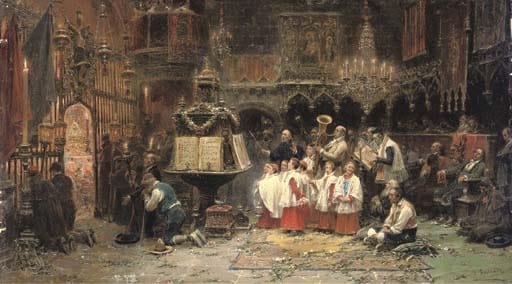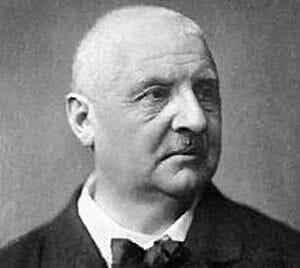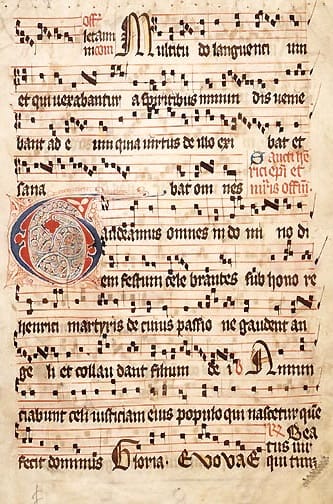Fourth Week of Lent 2025
On each week of Lent, Five Books for Catholics recommends a work for the season. Moreover, it aims to recommend different kinds of work: not just writings that expound Christian doctrine directly, but also works of literature, music, and art that help us contemplate the Lenten mysteries and enter into them. This week’s recommended work is a collection of sacred music by Giovanni Pierluigi da Palestrina (1525/26-1594).
You can find further suggested reading for Lent from the archive here and here.
Palestrina 6
The Sixteen, directed by Harry Christophers
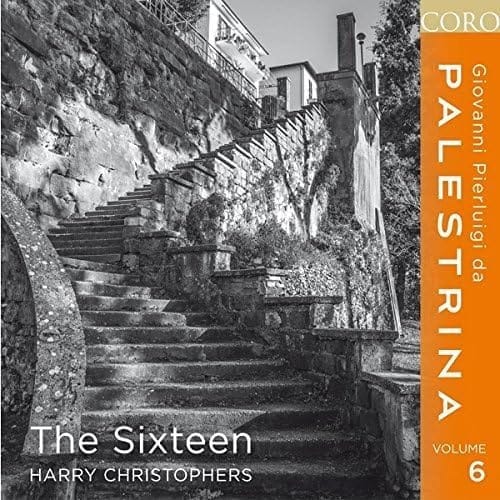
Last year, a selection of twentieth-century classical music for Lent was surveyed. This year it is worth harking back to the sixteenth-century and late Renaissance music: to commemorate the fifth centenary of Palestrina’s birth.
Giovanni Pierluigi hailed from Palestrina. In 1537, he became a choirboy of the Roman basilica of St. Mary Major, where he would have been exposed to the polyphony of Franco-Flemish composers then dominant in Rome.
In 1544, he was appointed organist and singer at the Cathedral of Palestrina. There, he may have caught the attention of the bishop, Cardinal Giovanni Maria Ciocchi del Monte, the future Julius III. The year after the election of Julius III, Palestrina moved definitively to Rome.
He served first as maestro of the Cappella Giulia, the choir for the solemn services of the chapter of St. Peter’s Basilica (1551-1554), and twenty years later he took up the position anew (1571-1594).
He also served for a while as a singer in the papal choir (Sistine Chapel Choir). However, he had to step down from that post in 1555. Paul IV had issued a motu proprio that excluded married men from the choir. At any rate, Palestrina was not out of work. He succeeded Orlande de Lassus as maestro at St. John Lateran (1555-1560), before passing to the same role at St. Mary Major (1561-1566) and the Roman Seminary (1566-1571). His occupancy of these prestigious posts means he was held in high regard by the ecclesiastics in Rome. As does his place of burial: St. Peter’s. Unfortunately, subsequent remodelling in the basilica covered his tomb, whose exact location is no longer known.
During this busy career as a Church musician, Palestrina composed an impressive body of sacred music that comprises 104 settings of the Common of the Mass and more than 250 motets.
As a composer, he was more a conservative than an innovator. He worked within the conventions of an existing tradition that had already be brought to new heights by Josquin des Prez and Cristobal de Morales. Nevertheless, Palestrina further refined this tradition and style. He surpassed in predecessors at shaping the music more closely to the text and layering the various voices seamlessly over one another. In that sense, he is an innovative composer.
He was also steeped in the older tradition of Gregorian chant. Not only did he teach it but began work on a revision of the Gradual.
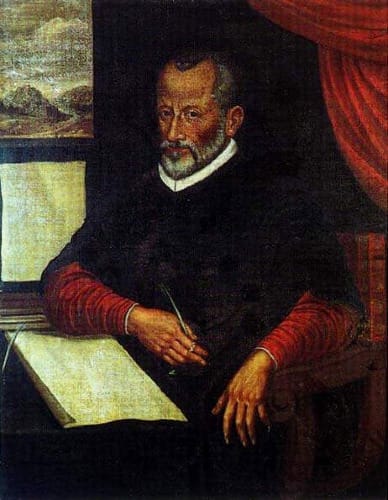
Palestrina’s fame was cemented from the eighteenth-century on. For various reasons, particularly in Germanophone lands, he came to be considered the supreme representative of Renaissance sacred music.
For Catholics, there was a strong reason to privilege Palestrina: his supposed role in swaying the Council of Trent against a proposed ban of polyphonic compositions in the liturgy.
As the story goes, a sizable contingent was pushing for this ban. It favoured the sobriety of Gregorian Chant over the latest polyphonic works. In the former, the text was enunciated clearly and not lost in elaborate, florid strands of counterpoint. Palestrina’s Missa Papae Marcelli, the story continues, persuaded the council fathers not to ban polyphonic compositions in the liturgy. It showed how the liturgical text could come across clearly even in a polyphonic setting. The composer Agostino Agazzari (1578-1640) appears to be one source of this story. The story was even brought to the stage in Hans Pfitzner’s opera Palestrina. However, it is just a legend.
Still, there is a grain of truth to it. The story concludes correctly that Palestrina’s approach to polyphony was simpler and more sober than that of other composers of the period.
Johann Joseph Fux picked up on this and other features of Palestrina’s style in his influential textbook on composition: the Gradus ad Parnassum (1725). The second part of the book is on counterpoint and takes Palestrina as the main model and master. Fux noted that, compared to other Renaissance polyphonists, Palestrina reduced the number, size, and impetus of leaps, favouring smoother melodic lines instead. He also called attention to Palestrina’s comparatively tempered use of dissonance. Generally, Palestrina confines dissonance to passing notes, weak beats, and suspensions. In the last case, he tends to resolve it immediately. Fux’s analysis was largely corroborated during the twentieth century in the studies of Knud Jeppesen.
“I always get upset when some praise only Beethoven, others only Palestrina and still others only Mozart or Bach. All four of them, I say, or none at all.”
Felix Mendelssohn
Fux’s influential textbook raised Palestrina’s profile in German speaking lands. However, Fux was not the Italian composer’s only proponent. Various other cultural movements shaped the reading and reception of Palestrina in eighteenth and nineteenth-century German culture. James Garratt has analysed them in his Palestrina and the German Romantic Imagination. One of the movements Garratt discusses is the Catholic Cecilian Movement. It was committed to the reform of sacred music and had a predilection for Palestrina. It cropped up in last year’s post on Bruckner’s sacred music.
The nineteenth-century German reception of Palestrina may have idealized him excessively and exaggerated his originality. Not only has scholarship on Palestrina matured since then. More importantly, the musicology of the period has expanded. A greater range of Renaissance composers has been studied. Current assessments of Palestrina’s place within Renaissance sacred music are more nuanced.

Of the many excellent recordings of works by Palestrina, hardly any are dedicated to his Lenten motets. However, volume 6 of The Sixteen’s Palestrina series includes, alongside three of the composer’s motets on the Song of Song and his L’homme armé Mass, a selection of seven motets and offertories that are penitential in character.
- Parce mihi Domine, a setting of Job 7:16-21 (track 1)
- Peccantem me quotidie (1572), a setting of the seventh Responsory of the Matins of the Office of the Dead (track 2)
- The offertory Si ambulavero in medio tribulationis, a setting of Psalm 138:7 (track 3)
- Tribulationes civitatum audivimus, a response loosely based on Judith 4 and 7 of the Vetus Latina (track 4)
- The offertory Super flumina Babylonis (By the rivers of Babylon) (Psalm 137:1) (track 5).
- The offertory De profundis clamavi (Out of the depths I cry to you O Lord), a setting of the opening verse of the last of the seven penitential psalms (Psalm 130) (track 9).
- Tribularer si nescirem, a response based on Ezekiel 33:11, Matthew 9:9: 15:22 and Luke 5:32 (track 16)
All but the last of these seven compositions are for five voices. When composing for five voices, Palestrina normally assigns two to tenors. In Super flumina Babylonis (By the rivers of Babylon), he opts for two contraltos instead. This is one indication of how he selects the ensemble best suited to the text. Moreover, the melody of this offertory is in the major. Doleful, it is tinged with hope. Instead of piling on the melodrama, Palestrina captures the deeper sentiments expressed in this prayer.
Often, he stresses the most significant phrases. For example, the first four bars of Tribulationes civitatum audivimus linger, with long notes, on the first word, tribulations (troubles). There are numerous repetitions of “me who sin” and “do not repent” at the opening of Peccantem me quotidie. In Tribularer, there are two series of nine repetitions of the cantus firmus (“Have mercy on me, God!”). In that series, each successive repetition rises a note, reaches the fifth, descends a note.
De profundis clamavi is another good example of how the composer responds to the text. To convey the prayer’s ascent to God from the depths, the opening rises from the tenors through the contralto to the soprano, whereas the melody falls a fifth before leaping up an octave.
At other times, as in the middle section of Peccantem me quotidie, Palestrina uses bold harmonies and modulations to capture the emotional intensity of the text.
“Peccantem me quotidie, et non me paenitentem,
timor mortis conturbat me:
Quia in inferno nulla est redemptio,
miserere, miserere mei, Deus, et salva me.”
“Fear of death troubles me,
who sin daily and do not repent thereof,
because in hell there is no redemption.
Have mercy! Have mercy on me, O God, and save me.”
In these works, as in the rest of his sacred music, Palestrina puts his art and craftsmanship at the service of liturgical prayer. They are meant to lead us into prayer and the contrite entreaty of God’s mercy. At the same time they express the beauty of his loving mercy.

